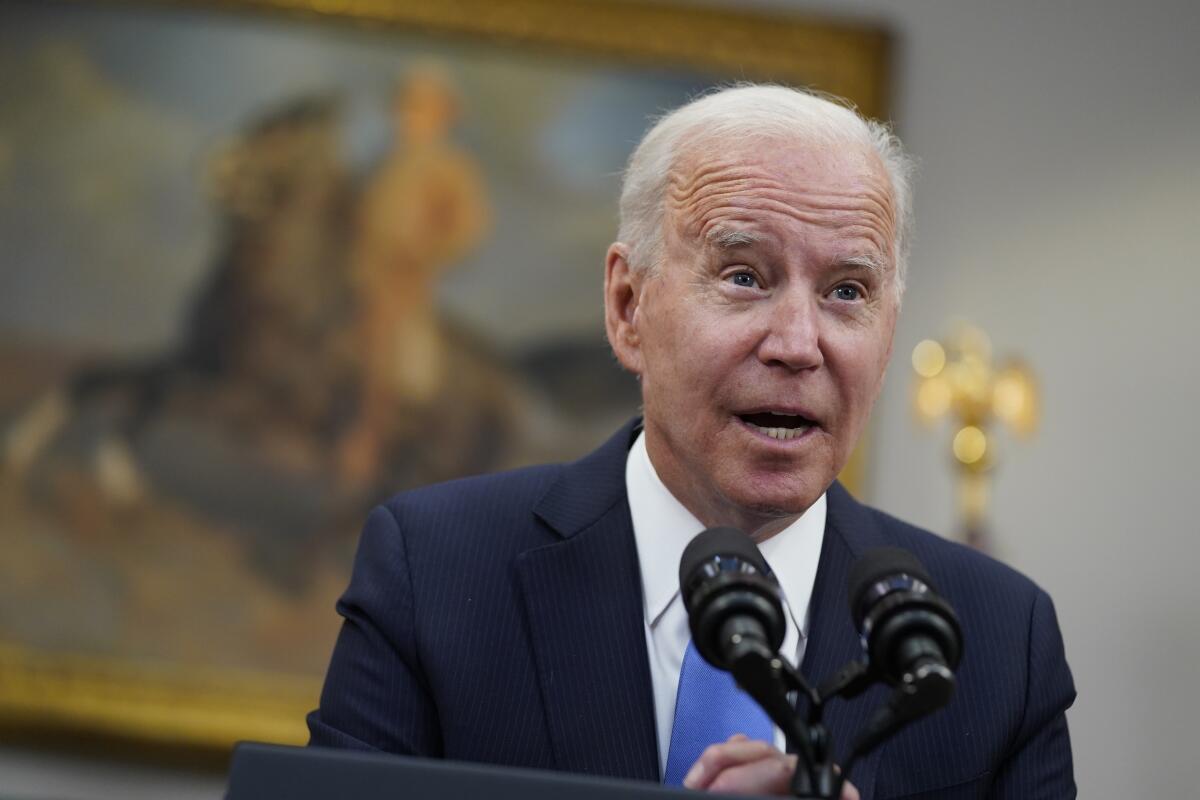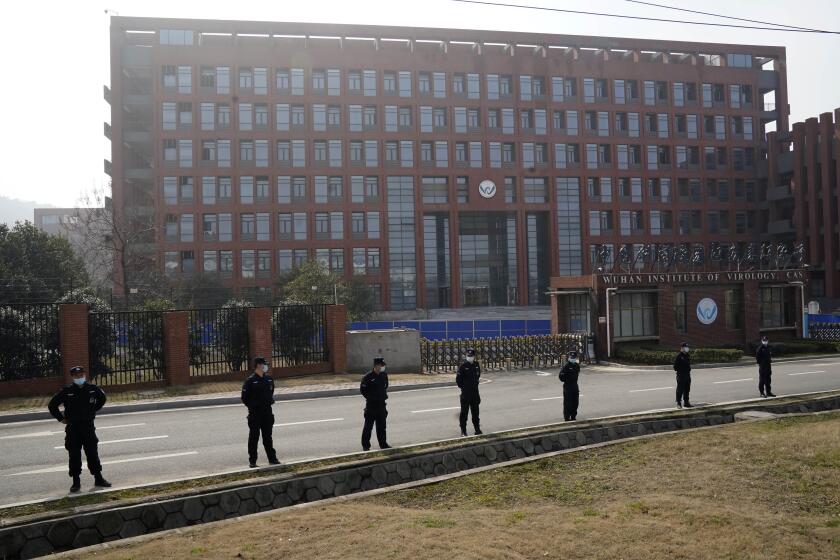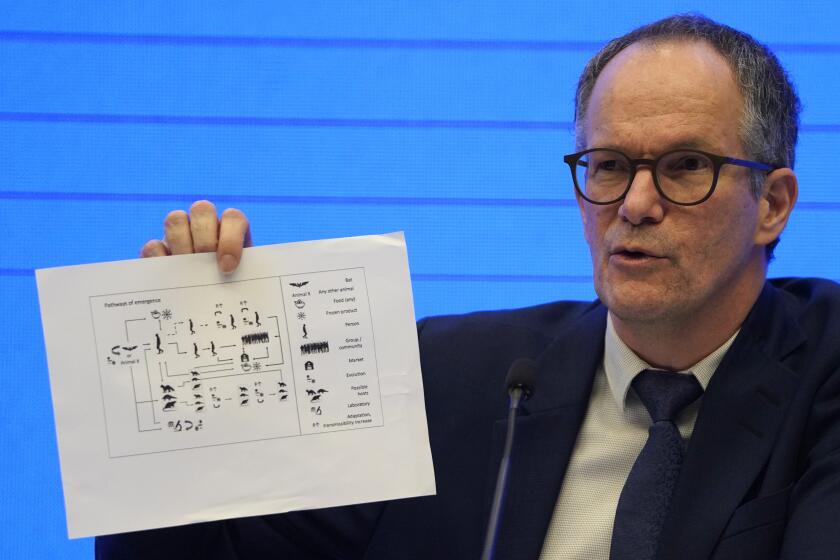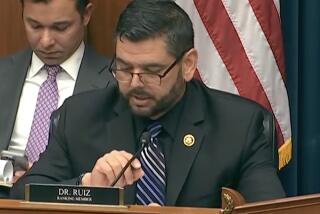Wuhan lab leak theory gets new look with Biden order to determine coronavirus’ origin

- Share via
WASHINGTON — President Biden on Wednesday ordered U.S. intelligence agencies to intensify their effort to determine the origins of the coronavirus that causes COVID-19, including whether the pandemic began with a lab accident in China.
The president’s directive was a rare public statement about an ongoing classified initiative, and it escalated much-debated questions about whether negligence by scientists in Wuhan could have played a role in the spread of a disease that has caused the deaths of about 3.5 million people worldwide.
“I have now asked the intelligence community to redouble their efforts to collect and analyze information that could bring us closer to a definitive conclusion, and to report back to me in 90 days,” Biden said in his statement. He asked intelligence officials to keep Congress updated and work closely with government laboratories.
The idea that the pandemic began at the Wuhan Institute of Virology, which is in the Chinese city where the earliest cases of COVID-19 were detected, was frequently dismissed as a fringe theory pushed by former President Trump and his political allies.
But scientists have said the possibility cannot be ruled out, especially because China has refused to allow a more thorough international investigation into activities at the Wuhan lab. U.S. personnel were not allowed to visit Wuhan during the pandemic’s earliest stages last year, and a more recent inquiry by the World Health Organization was widely considered to have been undermined by the Chinese government’s restrictions on the work.
In his statement released by the White House, Biden said the United States would work with its allies “to press China to participate in a full, transparent, evidence-based international investigation and to provide access to all relevant data and evidence.”
Beijing has not issued an official response to Biden’s statement. But Chinese officials repeatedly have rejected calls to examine whether the coronavirus came from the Wuhan lab, and they’ve described the WHO report as sufficient. Sometimes they’ve baselessly suggested the U.S. should be investigated as the potential source instead.
“For some people in the U.S., what they say is ‘facts,’ but what is really on their mind is political manipulation,” Chinese Foreign Ministry spokesman Zhao Lijian said at a Wednesday briefing. “Every time when the issue of pandemic is brought up, they smear and attack China.”
There’s wide agreement among scientists that the coronavirus known as SARS-CoV-2 could have evolved naturally, percolating among wild animals before making the jump to humans. Bats in particular are known to harbor different strains of coronavirus.
Spillover events from animals to humans have become increasingly frequent and consequential in recent decades, as civilizations have encroached ever more aggressively on wildlife, giving pathogens more opportunities to adapt and take root among people.
It’s unclear whether SARS-CoV-2 was being studied at the Wuhan Institute of Virology before it began circulating in the city of more than 11 million people and then spreading around the globe. The laboratory, located near the “wet” market from which China first argued the virus arose, has been known to gather field samples from high-risk environments, such as bat caves.
If the virus was indeed in the lab, workers could have been infected if they did not take sufficient safety precautions, such as wearing personal protective equipment. An infected worker could have brought the virus home and spread it to family members or others without even realizing it.
In 2018, State Department officials visiting the facility sent memos back to Washington expressing concern over unsafe laboratory practices there. In November 2019, three employees of the laboratory were hospitalized with symptoms consistent with COVID-19, according to previously undisclosed intelligence reported by the Wall Street Journal.
Scientists are urging their colleagues to dig deeper into the origins of the coronavirus behind the pandemic, including the possibility of a lab escape.
Biden’s announcement comes at a particularly sensitive time for Beijing. The whole country is preparing to celebrate the Chinese Communist Party’s 100th anniversary in July, a major event that President Xi Jinping expects to burnish his image as a restorer and upholder of Chinese greatness.
Control over the coronavirus narrative has been key to Xi cementing his power in the last year. Critics of China’s response to the outbreak and activists who documented the early days of COVID-19 in Wuhan have been detained, while those who lost family members to the virus during lockdown have been pressured to keep quiet.
Most proponents of a deeper investigation do not suggest that a potential lab leak was intentional. Nor do they argue that a lab incident was more likely than a natural spillover event. But in the absence of direct evidence pointing to either possibility, they say both should be more seriously considered.
The WHO-led mission to China this year was intended to evaluate all possibilities, but leaders around the globe believe it fell short. China delayed the mission for several months and, as part of the negotiations, had veto power over who would participate.
The team spent about three hours at the institute and was not given permission to interview staff members or review the lab’s biosafety records or database of viral sequences. That previously public database was taken offline in September 2019.
Some critics have also questioned why the WHO mission included Peter Daszak, the president of EcoHealth Alliance, a research organization with long-standing ties to the laboratory. Daszak had worked closely with Wuhan virologists on their coronavirus studies and therefore has a major conflict of interest, critics said.
At the end of the WHO-led mission, the team said it was “extremely unlikely” that the virus escaped from the Wuhan lab, ranking it below the possibility that the virus was transmitted via frozen food.
A World Health Organization team exploring the origins of the coronavirus concludes that it’s more likely to have jumped to humans from an animal.
The conclusions of the March report from WHO and China quickly came under scrutiny, and even WHO Director-General Tedros Adhanom Ghebreyesus said more research was needed.
“Although the team has concluded that a laboratory leak is the least likely hypothesis, this requires further investigation, potentially with additional missions involving specialist experts, which I am ready to deploy,” he said March 30.
A letter published this month in the journal Science and signed by more than a dozen prominent scientists was the latest call for a more careful examination into the origins.
Ben Deverman, a molecular biologist at the Broad Institute of MIT and Harvard who signed the letter, said that for him, it’s not about pointing fingers.
“This really matters, and not because we want to assign blame,” Deverman said. “We need to know the source of the pandemic so we can take the steps necessary to prevent the next one. It’s really detrimental that something like this has been politicized.”
One of the reasons for the heightened interest in the possibility of a lab leak is the fact that no wild animal has yet been found that carries SARS-CoV-2. In previous cases, including the 2002-03 outbreak of severe acute respiratory syndrome and the 2012 outbreak of Middle East respiratory syndrome, a host animal was identified in a matter of months.
More than 80,000 wildlife, livestock and poultry samples collected from 31 Chinese provinces have been tested, and none have contained a snippet of SARS-CoV-2’s genetic material or antibodies to the virus, said Akiko Iwasaki, a professor of immunobiology and epidemiology at Yale University who signed the letter in Science. But it’s still possible that a culprit will be found with further testing, she said.
Biden, in the statement, said he received an intelligence report this month saying there was disagreement among U.S. agencies about whether it’s more likely that the pandemic began with “human contact with an infected animal or from a laboratory accident.”
Neither scenario had particularly solid evidence, according to brief excerpts from the report. Each theory could be assessed only with “low or moderate confidence,” and most officials “do not believe there is sufficient information to assess one to be more likely than the other,” Biden’s statement said.
It is not unusual for different agencies to reach separate conclusions, reflecting the various methods that intelligence agents and analysts use to gather information. The CIA, for example, generally tries to pry secrets from human sources, while the National Security Agency relies largely on communications intercepts.
Rep. Adam B. Schiff (D-Burbank), chair of the House Intelligence Committee, said his panel was doing its own review of how the intelligence community responded to the spread of the virus.
“Beijing’s continued obstruction of a transparent, comprehensive examination of the relevant facts and data about the source of the coronavirus can only delay the vital work necessary to help the world better prepare itself before the next potential pandemic,” he said in a statement.
Dr. Anthony Fauci, the federal government’s top expert on infectious diseases, said Wednesday that “the most likely scenario is that this was a natural occurrence, but no one knows that 100% for sure.”
He added that “since there’s a lot of concern, a lot of speculation, and since no one absolutely knows that, I believe we do need the kind of investigation where there’s open transparency and all the information that’s available, to be made available, to scrutinize.”
Staff writers Alice Su in Beijing and Deborah Netburn in Los Angeles contributed to this report.
More to Read
Sign up for Essential California
The most important California stories and recommendations in your inbox every morning.
You may occasionally receive promotional content from the Los Angeles Times.














